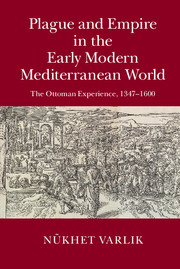Tracing Plague in the Ottoman Empire
hosted by Nir Shafir
Geneticists and historians are generally considered strange bedfellows. However, new advances in bio-archaeology and genetics are facilitating this odd coupling. In this episode, we speak to Nükhet Varlık, author of Plague and Empire in the Early Modern Mediterranean World : the Ottoman experience, 1347-1600 (Cambridge University Press), about how genetic evidence has transformed the study of the plague in the past ten years, allowing geneticists to more readily identify the presence of Yersinia pestis bacteria in human remains. Whereas before historians had been hesitant to diagnose diseases posthumously, they can now speak with greater certainty about the presence of plague. We then discuss the life of plague in the early modern Ottoman Empire in particular, focusing on the creation of ‘plague capitals’ in the urban centers of the Ottoman Empire following the conquest of Constantinople and how integrating the Ottoman experience of plague changes the story of how historians of medicine approach the topic. To inspire future collaborations among our listeners, we end with a peek at the process of working with geneticists and what such approaches can contribute to the study of the history of the Middle East.
This episode is part of an ongoing series entitled "History of Science, Ottoman or Otherwise."Stream via SoundCloud
PARTICIPANT BIOS
 |
Nükhet Varlık is Associate Professor of History at Rutgers University–Newark. She is a historian of the Ottoman Empire interested in disease, medicine, and public health. |
 |
Nir Shafir is a historian of the Middle East whose research examines the intersections of knowledge production, religious practice, and material culture in the early modern world (1400-1800). He curates Ottoman History Podcast’s series on history of science in addition to being one of the co-founders of hazine.info, a website that explores the archives and libraries of the Islamic world. He is currently an advanced doctoral candidate in the History Department at UCLA.
|
CREDITS
Episode No. 252
Release Date: 29 July 2016
Recording Location: Institute for Advanced Study, Princeton
Editing and production by Chris Gratien
Sound excerpts: Baglamamin Dugumu - Necmiye Ararat and Muzaffer; Katibim (Uskudar'a Gider iken) - Safiye Ayla; Egil Daglar Ustunden Asam - Viktoriya Hanim; Harmandali - Recep Efendi, Cemal Efendi
Special thanks to Muhtelif for allowing us to use "Bint El Shalabiya"
Images and bibliography courtesy of Nükhet Varlık
IMAGES
 |
| Pieter Coecke van Aelst (Netherlandish, Aelst 1502–1550 Brussels), Detail from a Turkish Funeral from the frieze Ces Moeurs et fachons de faire de Turcz (Customs and Fashions of the Turks), 1553 (Source: The Metropolitan Museum of Art, Harris Brisbane Dick Fund, 1928 - http://www.metmuseum.org/art/collection/search/375771) |
 |
| Nükhet Varlık Plague and Empire Cambridge University Press, 2015 |
Ayalon, Yaron. Natural Disasters in the Ottoman Empire: Plague, Famine, and Other Misfortunes. Cambridge University Press, 2014.
Bulmuş, Birsen. Plague, Quarantines and Geopolitics in the Ottoman Empire. Edinburgh University Press, 2012.
Campbell, Bruce M. S. The Great Transition: Climate, Disease and Society in the Late Medieval World. Cambridge: Cambridge University Press, 2016.
Gage, Kenneth L., and Michael Y. Kosoy. “Natural History of Plague: Perspectives from More Than a Century of Research.” Annual Review of Entomology 50, no. 1 (2005): 505–28.
Green, Monica H., ed. Pandemic Disease in the Medieval World: Rethinking the Black Death. The Medieval Globe, 1. Kalamazoo: Arc Medieval Press, 2015.
Green, Monica H. and Boris Schmid. “Plague Dialogues: Monica Green and Boris Schmid on Plague Phylogeny (I and II).” Contagions (blog). June 27-29, 2016.
Little, Lester K. “Plague Historians in Lab Coats.” Past and Present 213, no. 1 (2011): 267–90.
McNeill, William Hardy. Plagues and Peoples. Garden City, N.Y.: Anchor Press, 1976.
Panzac, Daniel. La peste dans l'Empire Ottoman, 1700-1850. Leuven: Éditions Peeters, 1985.
Slack, Paul. Plague: A Very Short Introduction. New York: Oxford University Press, 2012.
Varlik, Nükhet. Plague and Empire in the Early Modern Mediterranean World: The Ottoman Experience, 1347-1600. Cambridge University Press, 2015.
White, Sam. 2010. "Rethinking Disease in Ottoman History". International Journal of Middle East Studies. 42, no. 4: 549-567.











Comments
Post a Comment
Due to an overwhelming amount of spam, we no longer read comments submitted to the blog.